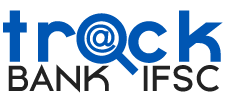Track Bank IFSC: Online IFSC Code Address of India Banks
- Select your bank from the 1st drop-down list
- Select your state from the 2nd drop-down list
- Select your district from the 3rd drop-down list
- Select the branch of your bank from the 4th drop-down list
-
What is an IFSC Code?
Indian Financial System Code (IFSC) is a unique 11-digit code allocated by Reserve Bank of India (RBI) to each bank branches in India which are contributing to online fund transfer systems like RTGS (Real-Time Gross Settlement), NEFT (National Electronic Fund Transfer) and IMPS (Immediate Payment Service).
IFSC code ensures that the cash is transferred to the proper account. The IFSC code of the bank is usually found on bank’s cheque leaves. The first four digits denote the bank. Then it is followed by digit zero. The last six digits denote the bank branch. In order to make online fund transfer to any bank account, one should know the IFSC code of the recipient's bank branch.
With online IFSC code finder, you'll easily find the IFSC code consistent with the situation you would like . To find the IFSC code of the bank, you need to select the name of the bank, state and district where the bank is situated and bank branch. Once providing the details, your bank’s IFSC code will appear along with the information such as your bank, state, district, city, branch, branch code, address and contact number.
Before making any fund transfer, you have to check with the bank whether the IFSC code of the recipient account’s bank branch is correct or not, to avoid any wrong transactions.
-
What is a MICR Code?
Magnetic Ink Character Recognition (MICR) may be a printing technology utilized in the banking system to print the MICR code. MICR code is a unique 9-digit code allocated by Reserve of India (RBI) to the bank branches in India which are contributing to Electronic Clearing System (ECS).
The MICR code is typically printed on rock bottom of the cheque leaf which facilitates easy processing. Also, it is found on the first page of the bank passbook. The first three digits denote city code, the middle three digits denote bank code and the last three digits denote branch code. With this code, machines can process cheques faster.
MICR code is mandatory for online fund transfers. As the MICR code is printed with ink , machines can easily read the code, thus minimizes errors.
By using online MICR code finder, you'll easily find your bank’s MICR code. To find MICR code, provide your bank’s name, state, district and bank branch. The MICR code will appear along with the details of your bank branch.
-
What is NEFT?
National Electronic Funds Transfer (NEFT) is a fund transfer process available with Reserve Bank of India (RBI). By using NEFT, peoples can easily transfer money from one bank to another bank with help of their account.
Funds also can be transferred via NEFT in online by using internet banking service. There is no max and min limit set for transactions with NEFT.
Nevertheless, the maximum transaction is limited to Rs. 50,000 per transaction. Depending on the amount of transaction, charges are applied. NEFT is right for little and medium amount transfer between bank accounts. In order to transfer funds through NEFT, the remitter should have beneficiary’s details like name, bank name, account number and IFSC code.
NEFT works on hourly batches. For fund transfer to require place, both the banks where the remitter and beneficiary have their account should have NEFT service. The transferred funds will be credited to the beneficiary’s account within two days.
-
What is IMPS?
Immediate Payment System (IMPS) is an electronic fund transfer system operated by the National Payments Corporation of India (NPCI) and supported by Reserve Bank of India (RBI) in which the person who sends a payment can immediately transfer funds from one account to another account.
IMPS is a 24 hours service, peoples can use this service Monday to Sunday i.e 7 days in a week. It is a mobile-based system, many banks offer this service via ATM and Internet banking too. It’s a chargeable service, charges may be differ bank to bank.
The min and max transaction limits will change based on banks norm. To transfer funds via IMPS, the person who sends a payment should know the beneficiary’s account number and bank’s IFSC code. It is an immediate payment service.
Funds can be transferred using the beneficiary’s MMID (Mobile Money Identifier) and mobile number or else by using an account number and IFSC code. By using the mobile application of the respective bank, you'll instantly transfer funds anytime.
-
What is RTGS?
Real Time Gross Settlement (RTGS) is an electronic fund transfer system which is used to transfer money from one bank account to another. By using the internet banking facility, you can easily transfer funds through RTGS on your own. The transactions in RTGS are settled grossly in real-time. Funds will be credited to the beneficiary’s account within 30 minutes. The minimum amount which will be transferred through RTGS is Rs. 2 lakhs and there is no maximum limit. To initiate fund transfer in RTGS, the person who sends a payment should have beneficiary’s name, bank name, IFSC code and account number. In order to form transactions through RTGS, both the banks where the remitter and therefore the beneficiary have their account, should contain RTGS facility.
As the fund transfer in RTGS is controlled by Reserve Bank of India (RBI), the transactions are unchangeable and hence, it is final. Depending on the transaction amount, the remitter are going to be applied some charges. RTGS is meant especially for large amount transactions. RTGS service will be available only on working days.
